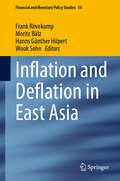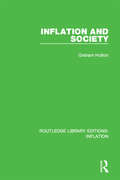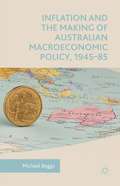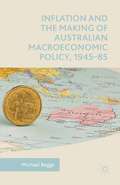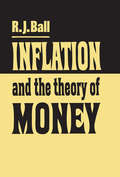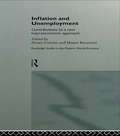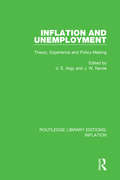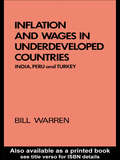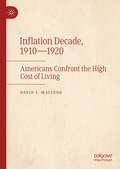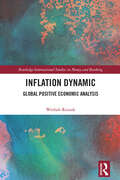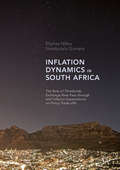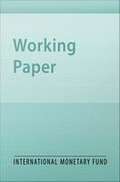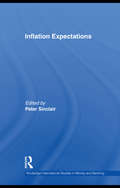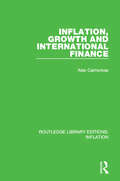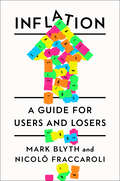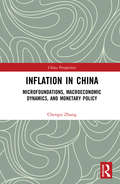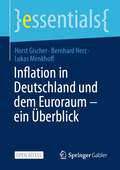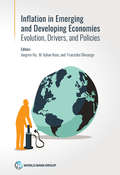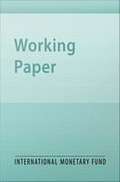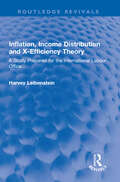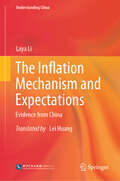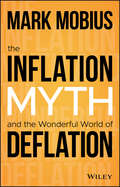- Table View
- List View
Inflation and Deflation in East Asia (Financial and Monetary Policy Studies #54)
by Frank Rövekamp Moritz Bälz Hanns Günther Hilpert Wook SohnIn light of the deflationary trends following the 2008/2009 financial crisis, as well as the return of inflation triggered by the COVID-19 pandemic and the war in Ukraine, this book offers insights into price stability issues in various East Asian countries. Leading scholars from the fields of economics and law as well as central bank practitioners present case studies on Japan, Korea, Singapore, and Taiwan. The contributors address topics such as quantitative monetary easing, the role of global and domestic shocks on inflation dynamics, and other monetary policy issues. In doing so, the book goes into detail about the individual forces and effects of deflation and inflation and compares the Asian experience with that of the Eurozone.
Inflation and Society (Routledge Library Editions: Inflation)
by Graham HuttonOriginally published in 1960, this book examines how inflation as a policy has come about in modern democracies, how ti works, how to avoid it and at what cost. In non-technical terms it explains what inflation does, both to society and its individual elements, to weaken and hamper democracy. Including examples from the UK, Germany, France, Scandinavia, the USA and the former Soviet Union this volume examines inflation at work in widely differing communities since Roman Times to the late twentieth century.
Inflation and the Making of Australian Macroeconomic Policy, 1945–85
by Michael BeggsInflation and the Making of Australian Macroeconomic Policy, 1945–85.
Inflation and the Making of Australian Macroeconomic Policy, 1945–85
by Michael BeggsIn the decades after World War II, inflation undermined the aspiration for full employment in Australia. This book tells the story of how the Australian state was shaped by the confrontation with monetary instability: a pre-history of neoliberalism.
Inflation and the Theory of Money
by R. J. BallMartin Bronfenbrenner in the Journal of Finance had this to say when the book was first released "A thoughtful, scholarly, and systematic treatise on the economics of inflation. If this reviewer were asked to hang a course on inflation theory upon one single text, it would almost certainly be this one."The principal concern of this book is to set out the elements that enter into problems of analyzing inflation. This detailed, readable review of contemporary theory on the problems of inflation fills an important gap in the literature on macro-economics that: 1) assesses the implications of inflationary processes for economic policy; 2) synthesizes a general framework within which to illustrate inflationary processes; 3) reconciles the approaches of "demand inflation" and "cost inflation"; and 4) analyzes the determination and behavior of the general price level in an exchange economy.The first part of the book reviews neo-classical and "Keynesian" type models of the closed macro-economy, analyzes determination of the general price level, and introduces a restatement of conventional employment theory with emphasis on the general price level.The second part considers the problems of price and wage determinations and the demand for money in more detail, synthesizing the analyses into a model of the macro-economy and discussing the implications of this model and the preceding analysis for economic policy. Describing alternative approaches to the theory of inflation, each of which has resulted in partial theories, the book avoids fragmentary explanations by setting the entire discussion in the context of a macro-economic general equilibrium framework.
Inflation and Unemployment: Contributions to a New Macroeconomic Approach (Routledge Studies in the Modern World Economy)
by Mauro Baranzini Alvaro CenciniThis work challenges traditional monetary theory by focusing on the role of banks and provides a new insight into the role played by bank money and capital accumulation. An international team of contributors reappraise analyses of the inflation and unemployment developed by Marshall, Keynes and Robertson. This volume is published in association with the Centre for the Study of Banking in Switzerland.
Inflation and Unemployment: Theory, Experience and Policy Making (Routledge Library Editions: Inflation)
by J. W. Nevile V. E. ArgyOriginally published in 1985 and contributed to by internationally renowned economists, this volume discusses theoretical issues and country-specific experiences to review the underlying causes of the stagflation of the 1970s and early 1980s, as well as summarizing the kinds of macro-policies that were adopted to deal with the stagflation.
Inflation and Wages in Underdeveloped Countries: India, Peru, and Turkey, 1939-1960
by Bill WarrenPublished in the year 1977, Inflation and Wages in Underdeveloped Countries is a valuable contribution to the field of Economics.
Inflation Decade, 1910—1920: Americans Confront the High Cost of Living
by David I. MacleodThis book shows how inflation can disrupt politics and society. With no recent precedent, mild inflation spurred mass protests, myriad remedial schemes, and partisan political reversals between 1910 and 1914. Then wartime demand and inflationary fiscal policy doubled consumer prices from 1915 to 1920, triggering waves of strikes, food riots by immigrant housewives, class conflict, and elite fears of revolution. Middle-class households resented falling real incomes. Even more than today, food prices dominated consumer concerns. Yet farmers wanted high commodity prices. Accordingly, both sides blamed and attacked meatpackers, wholesalers, and retailers. Then as now, inflation hurt whichever party held the White House. Fumbling responses by Wilson’s administration and the Federal Reserve led to hesitant price controls, punitive raids and prosecutions, and a now-familiar fallback—high interest rates in 1920 and subsequent recession. An epilogue traces continuing popular and politicalresponses to changes in the consumer price index down to 2020.
Inflation Determinants in Paraguay: Cost Push versus Demand Pull Factors
by Brieuc Monfort Santiago PeñaA report from the International Monetary Fund.
Inflation Dynamic: Global Positive Economic Analysis (Routledge International Studies in Money and Banking)
by Weshah RazzakThis book explains inflation dynamic, using time series data from 1960 for 42 countries. These countries are different in every aspect, historically, culturally, socially, politically, institutionally, and economically. They are chosen on the basis of the data availability only and cover the Middle East and North Africa (MENA) region, Africa, Asia, the Caribbean, Europe, Australasia, and the United States. Inflation reached double digits in the developed countries in the 1970s and 80s, and then central banks, successfully stabilized it by anchoring inflation expectations for decades, until now. Conditional on common and country-specific shocks such as oil price shocks, financial and banking and political crises, wars, pandemics, natural disasters etc., the book tests various theoretical models about the long and short run relationships between money and prices, money growth and inflation, money growth and real output, expected inflation; the output gap, fiscal policy, and inflation, using a number of parametric and non-parametric methods, and pays attention to specifications and estimations problems. In addition, it explains why policymakers in inflation – targeting countries, e.g. the U.S., failed to anticipate the recent sudden rise in inflation. And, it examines the fallibility of the Modern Monetary Theory’s policy prescription to reduce inflation by raising taxes. This is a unique and innovative book, which will find an audience among students, academics, researchers, policy makers, analysts in corporations, private and central banks and international monetary institutions.
Inflation Dynamics in South Africa
by Eliphas Ndou Nombulelo GumataThis book offers a comprehensive empirical analysis of South African inflation dynamics, using a variety of techniques including counterfactual analysis. The authors elaborate the roles in inflation of thresholds, nonlinearities and asymmetries introduced by economic conditions such as the size of exchange rate changes and volatility, GDP growth, inflation, output gap, credit growth, sovereign spreads and fiscal policy, providing new policy evidence on the impact of these. Ndou and Gumata apply techniques to determine the prevalence of updating inflation expectations, and reconsider the propagation effects of a number of inflation risk factors. Asking to what extent the evidence points to a need to enforce price stability and the anchoring of inflation expectation, the book fills existing gaps in South African Policy, and maintains a clear argument that price stability is consistent with the 3 to 6 per cent inflation target range, and that threshold application should form an important aspect of policy analysis in periods of macroeconomic uncertainty. As such, the book serves as an excellent reference text for academic and policy discussions alike.
Inflation Dynamics in Yemen: An Empirical Analysis
by Abdullah AlmounsorA report from the International Monetary Fund.
Inflation Expectations (Routledge International Studies In Money And Banking Ser. #56)
by Peter SinclairInflation is regarded by the many as a menace that damages business and can only make life worse for households. Keeping it low depends critically on ensuring that firms and workers expect it to be low. So expectations of inflation are a key influence on national economic welfare. This collection pulls together a galaxy of world experts (including Roy Batchelor, Richard Curtin and Staffan Linden) on inflation expectations to debate different aspects of the issues involved. The main focus of the volume is on likely inflation developments. A number of factors have led practitioners and academic observers of monetary policy to place increasing emphasis recently on inflation expectations. One is the spread of inflation targeting, invented in New Zealand over 15 years ago, but now encompassing many important economies including Brazil, Canada, Israel and Great Britain. Even more significantly, the European Central Bank, the Bank of Japan and the United States Federal Bank are the leading members of another group of monetary institutions all considering or implementing moves in the same direction. A second is the large reduction in actual inflation that has been observed in most countries over the past decade or so. These considerations underscore the critical – and largely underrecognized - importance of inflation expectations. They emphasize the importance of the issues, and the great need for a volume that offers a clear, systematic treatment of them. This book, under the steely editorship of Peter Sinclair, should prove very important for policy makers and monetary economists alike.
Inflation Expectations and Monetary Policy in India: An Empirical Exploration
by Michael Debabrata Patra Partha RayA report from the International Monetary Fund.
Inflation, Growth and International Finance (Routledge Library Editions: Inflation)
by Alec CairncrossThis book, originally published in 1975, deals with the sources of economic growth, inflation and the prospects of bringing it under control, floating exchange rates and restrictions on international capital movements. Although aimed at the non-specialist, professional economists willa slo find the book stimulating.
Inflation: A Guide for Users and Losers
by Mark Blyth Nicolò Fraccaroli"An essential dose of clear thinking on one of the most contentious issues in economic policy." —Adam Tooze A fresh, revealing, and myth-busting guide to the ins and outs of inflation from two leading political economists. Inflation is back, and its impact can be felt everywhere, from the grocery store to the mortgage market to the results of elections around the world. What's more, tariffs and trade wars threaten to accelerate inflation again. Yet the conventional wisdom about inflation is stuck in the past. Since the 1970s, there has only really been one playbook for fighting inflation: raise interest rates, thereby creating unemployment and a recession, which will lower prices. But this simple story hides a multitude of beliefs about why prices go up and how policymakers can wrestle them back down, beliefs that are often wrong, damaging, and have little empirical basis. Leading political economists Mark Blyth and Nicolò Fraccaroli reveal why inflation really happens, challenge how we think about it, and argue for fresh approaches to combat it. With accessible and engaging commentary, and a good dose of humor, Blyth and Fraccaroli bring the complexities of economic policy and inflation indices down to earth. Policymakers around the world may have pulled off a so-called "soft landing," but Inflation warns they must update their thinking. Now tariffs, climate shocks, demographic change, geopolitical tensions, and politicians promising to upend the global order are all combining to create a more inflationary future, making a new paradigm for understanding inflation urgently necessary. Astute, timely, and engaging, Inflation is a must-read for anyone seeking to understand the forces shaping our economy and politics.
Inflation Hedging for Long-Term Investors
by Alexander P. Attié Shaun K. RoacheA report from the International Monetary Fund.
Inflation in China: Microfoundations, Macroeconomic Dynamics, and Monetary Policy (China Perspectives)
by Chengsi ZhangInflation plays a central role in macroeconomic and financial policy regulation, and its dynamic formation has gradually become a popular research topic in this field. This book comprehensively studies the dynamic mechanism of inflation in China from the perspective of New Keynesian economics. By combining the dynamic trajectory of price changes since China's reform and opening-up under Deng Xiaoping as well as the underlying economic operating characteristics, the book deploys a multifaceted approach to understand the mechanism of inflation dynamics. The author explores the microfoundations of inflation dynamics, and underlines their importance in the context of modern monetary policy. In particular, he builds upon the traditional New Keynesian Phillips curve to include factors of globalization and financialization within the inflation formation regime of modern China. As the book explores the dynamic mechanism of China's inflation from different perspectives including inflation cycle theory, price index internal conduction, price index chain transmission, capital rotation, and industry inflation mechanisms, international readers will gain a full understanding of China's inflation, monetary policy, and economy.
Inflation in Deutschland und dem Euroraum – ein Überblick (essentials)
by Horst Gischer Bernhard Herz Lukas MenkhoffDer vorliegende Open-Access-Band analysiert die relevanten ökonomischen Zusammenhänge der Inflation in Bezug auf die Entstehung und die Folgen von nachhaltigen Steigerungen des Preisniveaus einer Volkswirtschaft. Nach einer langen Periode stabiler Preise ist die Gefahr einer dauerhaften Inflation unerwartet wieder in den Blickpunkt von Wirtschaft und Politik geraten. Begleitend werden die Messkonzepte der Inflation sowie die Möglichkeiten und Grenzen zur Wiederherstellung der Geldwertstabilität durch eine Zentralbank beschrieben.
Inflation in Emerging and Developing Economies: Evolution, Drivers, and Policies
by Jongrim Ha M. Ayhan Kose Franziska OhnsorgeThis is the first comprehensive study in the context of EMDEs that covers, in one consistent framework, the evolution and global and domestic drivers of inflation, the role of expectations, exchange rate pass-through and policy implications. In addition, the report analyzes inflation and monetary policy related challenges in LICs. The report documents three major findings: In First, EMDE disinflation over the past four decades was to a significant degree a result of favorable external developments, pointing to the risk of rising EMDE inflation if global inflation were to increase. In particular, the decline in EMDE inflation has been supported by broad-based global disinflation amid rapid international trade and financial integration and the disruption caused by the global financial crisis. While domestic factors continue to be the main drivers of short-term movements in EMDE inflation, the role of global factors has risen by one-half between the 1970s and the 2000s. On average, global shocks, especially oil price swings and global demand shocks have accounted for more than one-quarter of domestic inflation variatio--and more in countries with stronger global linkages and greater reliance on commodity imports. In LICs, global food and energy price shocks accounted for another 12 percent of core inflation variatio--half more than in advanced economies and one-fifth more than in non-LIC EMDEs. Second, inflation expectations continue to be less well-anchored in EMDEs than in advanced economies, although a move to inflation targeting and better fiscal frameworks has helped strengthen monetary policy credibility. Lower monetary policy credibility and exchange rate flexibility have also been associated with higher pass-through of exchange rate shocks into domestic inflation in the event of global shocks, which have accounted for half of EMDE exchange rate variation. Third, in part because of poorly anchored inflation expectations, the transmission of global commodity price shocks to domestic LIC inflation (combined with unintended consequences of other government policies) can have material implications for poverty: the global food price spikes in 2010-11 tipped roughly 8 million people into poverty.
Inflation in Tajikistan: Forecasting Analysis and Monetary Policy Challenges
by Fahad Alturki Svetlana VtyurinaA report from the International Monetary Fund.
Inflation, Income Distribution and X-Efficiency Theory: A Study Prepared for the International Labour Office... (Routledge Revivals)
by Harvey LeibensteinFirst published in 1980, Inflation, Income Distribution and X-Efficiency Theory presents an exploratory theoretical study of the linkages between income distribution, the degree of X-efficiency, and inflation and the level of employment in the context of developing society. It discusses themes like concept of income distribution; maximization versus non-maximization models; theory of inert areas; microtheory and inflation; monopoly and X-Efficiency theory; contracts, bargaining and inflation; theory of bargaining; survival strategies in the face of inflation; and policy implications of inflation. This book is a must read for students and scholars of macroeconomics and economics in general.
The Inflation Mechanism and Expectations: Evidence from China (Understanding China)
by Laya LiThis book reflects China's experience, model and theory of successful inflation control. The idea of Stabilization of Expectations emphasized by the Chinese government was primarily proposed in this book with systematic theoretical support. The theory framework initiated in this book has been about 10 years earlier than that of the European and American economists. The core theory of this work is Sticky Expectation Theory, which breaks through the framework of neoclassical economic theory, denies the fundamental preconditions of neoclassical economic theory to establish a new theoretical framework so as to understand people's economic behavior and explain the operating mechanism of economy. This book establishes the Chinese version of flexible inflation targeting system, policy transparency, policy rules, and expectation management as the means to prevent and manage inflation and macro-control. Readers will gain a better understanding of the research achievements of Chinese scholars in the field of inflation management as well as the theory of expectations. Readers can further understand the Chinese approach in tackling inflation issue and other macro-economic control measures proposed by this book.
The Inflation Myth and the Wonderful World of Deflation
by Mark MobiusWhat if everything you’ve learned about inflation is wrong? The Inflation Myth and the Wonderful World of Deflation illustrates our rapidly changing world where constant technological innovation leads to cheaper and better products. These changes are no longer reflected in the ways we measure inflation. Renowned investor and author Mark Mobius persuasively argues that what we believe to know about inflation today does not reflect the reality any longer. It is a myth, a legend, a fable, and, yes, a falsehood for a number of reasons. The Inflation Myth and the Wonderful World of Deflation tackles a number of fascinating topics, including: The political nature of inflation measurement where governments manipulate and exploit inflation numbers to fit their economic programs The extreme difficulty involved in gathering accurate data to measure inflation and the resulting inaccuracy of those measures The error of using currencies to measure inflation when those currencies are continually being debased by the governments who issue them Finally, and most importantly, the advances in technology and automation which are leading to continuously falling costs for goods and services Perfect for anyone with even a passing interest in macroeconomic phenomena or government policies, which are significantly impacting people’s everyday lives around the world, The Inflation Myth and the Wonderful World of Deflation provides a remarkably compelling and provocative view of stunning originality.
